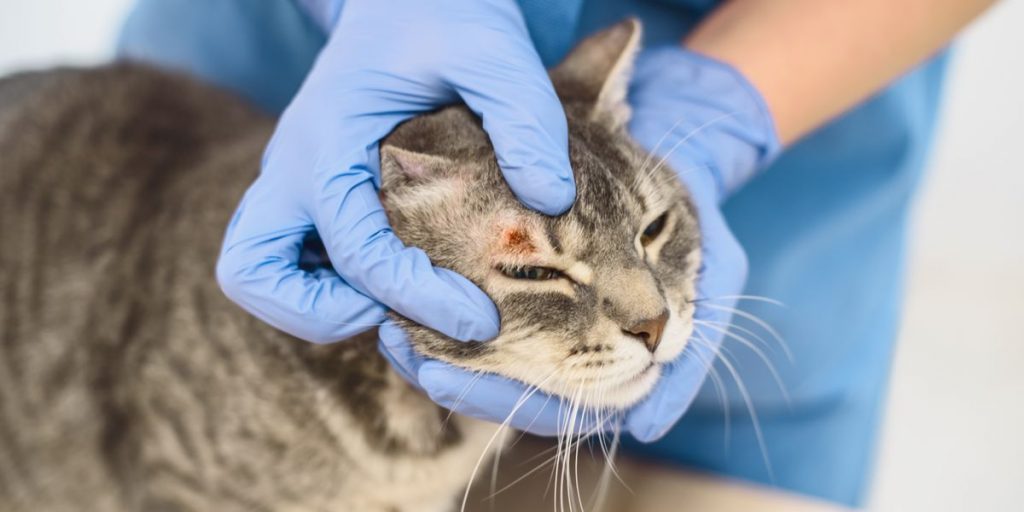Cats with Ringworm: Signs, Diagnosis, and Treatment
Ringworm is without a doubt one of the most misunderstood of all medical terminology. Ringworm in cats isn’t caused by parasites, despite the fact that many people think it is.
Fungal infection of the skin is the most common cause of ringworm in cats, which is also known as dermatophytosis. The fungus Microsporum canis is the most common cause.
What Causes Ringworm in Cats?
The problem with ringworm is that it is impossible to escape. Fungal organisms can be found in almost any part of the environment and can cause cat ringworm. Soil-dwelling fungus flourishes best in hot, moist conditions.
When it comes to the spread of Ringworm, the fungus spores aren’t limited to the earth; they’re small enough to be carried indoors by blankets, clothing, and fur, where they can thrive.
There are many types of fungal infections, but the most common are caused by parasites that feed on live organisms. Hair, nails, and skin are the primary sources of keratin for this parasite.
Despite the fact that a cat may become infected with ringworm even if the fungus is present, this does not necessarily guarantee that the cat will develop a ringworm infection, according to Cornell Feline Health Center.
Self-grooming cats can remove the fungus from their own hair once it has set in. Bacteria living on the cat’s skin may outnumber and eventually eliminate the fungus, or the fungus may persist and thrive in its current location.
WHILE SOME CATS WITH RINGWORM ARE ASYMPTOMATIC, OTHERS SHOW CLINICAL INDICATIONS OF THE INFECTION.
In Cats, What Is the Significance of Ringworm?
The only component of the disease’s name that can be attributed to those who first discovered it is “ringworm,” which appears as a circular reddish rash on an affected cat’s skin. Cats’ coats might become drab or stubby as a result of hair loss.
SKIN AND NAIL INFECTIONS ARE OTHER SYMPTOMS THAT CAN DEVELOP ALONG THE WAY, SUCH AS HAIR LOSS, SCALING, AND ITCHING ON THE SCALP OR BODY.
Cat Ringworm: How Common Is It?
In contrast to other diseases, ringworm is one of the most common infectious skin infections in cats globally. Kittens with weakened immune systems are more susceptible to illness, but it can harm any cat.
Additionally, long-haired cat breeds, cats in high-population situations (such as catteries), cats with other systemic disorders that may compromise their immune system, or cats with inadequate nutrition are also more susceptible to feline leukaemia.
Is Ringworm Something I Should Be Concerned About?
Yes, and no. Even though ringworm in cats isn’t normally dangerous, the disease can spread to humans and other animals like dogs. An infected person can pass on the disease to another person through direct touch.
IT CAN BE CARRIED IN A VARIETY OF WAYS, FROM CATS TO DOGS TO HUMANS.
When there is a breach in the skin, such as a scratch on the skin, adult humans are normally resistant to infection.
HOWEVER, CHILDREN AND PEOPLE WITH IMPAIRED IMMUNE SYSTEMS ARE MORE VULNERABLE TO INFECTION.
If you discover any suspicious skin lesions that resemble those seen in cats, you should consult your doctor right once. To our relief, because of our superior level of hygiene, topical anti-fungal cream or spray may be all that is required for human treatment.
WHEN DEALING WITH A RINGWORM INFECTION, DON’T FORGET ABOUT THE ENVIRONMENT.
For up to 18 months, the fungus spores can remain in bedding or carpet.
For disinfection and killing fungal spores, bleach and water can be used together. Disinfecting hard surfaces can be done with just 500 ml of chlorine bleach and a gallon of water. This is critical in order to keep the illness from returning.
In cats, what is the best way to treat Ringworm?
As much as no one like dosing cats with oral pills, ringworm can be treated with topical antifungal medications in the form of creams and spray. Using clippers and veterinary-supplied dips can also be helpful in eradicating the illness.
Itraconazole, an oral antifungal medicine, is frequently used for infections that have progressed beyond the localized area or for infections that have not responded to topical treatment.
IT IS POSSIBLE TO FLAVOUR THEM TO RESEMBLE TUNA OR OTHER POPULAR CAT TREATS IN ORDER TO MAKE ADMINISTERING ORAL DRUGS MORE CONVENIENT.
Environmental decontamination, as previously said, is always a vital aspect of treatment in order to stop the transmission cycle.
It is the only way to fully monitor a cat’s response to treatment with a dermatophyte culture. Treatment can take weeks or months if the illness is widespread or highly resistant.
Hair loss and lesions should be examined and diagnosed as soon as possible, rather than waiting until it’s too late.
In what ways can I keep my cat from getting ringworm?
Cat ringworm prevention is difficult, but not impossible. First and foremost, ringworm is less likely to develop in a healthy cat with a good coat and skin.
A cat’s skin and hair follicles are a breeding ground for fungus spores, thus proper nutrition is essential.
In the event you introduce a new cat into your home, consider a quarantine time and a culture for ringworm organism, especially if the new cat displays any signs of an unhealthy coat or skin.
Prophylactic treatment with oral drugs for up to two weeks may be an option if your pet is exposed to an animal with known ringworm.
Once infected, ringworm can take weeks or even months to clear up. The best approach to prevent your cat from getting an unpleasant and long-lasting fungal skin infection is to keep them healthy.
Fact-Finding:
Thanks for reading and have a great day! Cats with Ringworm: Signs, Diagnosis, and Treatment!
Please post your thoughts in the comments section if you have any. Please feel free to share!

